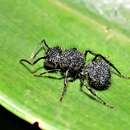en
names in breadcrumbs


Head transverse; eyes small, placed laterally, high on the head; antennae 12-jointed, inserted forwards on the head, wide apart; the labial palpi 4-jointed, the three basal ones of about equal length, clavate; the apical joint as long as the two preceding joints united; the maxillary palpi 5-jointed, elongate, the three apical joints long and slender, the two basal ones much shorter and stouter; mandibles short, stout, and of equal width throughout, armed with five stout teeth. Thorax oblong-quadrate; legs of moderate length; tarsi 5-jointed; each tibia armed with a single spine at the apex. Abdomen globose; peduncle formed of a single node; the first segment very large, concealing the other segments beneath it.
E. nigra; capite, thorace et abdomine longitudinaliter striatis; thorace oblongo, subquadrate; pedunculo transverso.
Worker. Length 3 lines. Black; the head, thorax and abdomen finely striated longitudinally; the head with an obscure blue tinge; the palpi pale rufo-testaceous. Thorax: oblong, the margins denticulate, the anterior margin rounded, the lateral margins narrowed to the middle, and again widened posteriorly; above slightly arched; the division of the pro- and meso-thorax distinctly marked by a suture; that of the meso- and meta-thorax by a deep strangulation; the peduncle of the abdomen incrassate, transverse, and armed on each side by a stout spine. The entire insect thinly, sprinkled with erect black hairs.
Hab. Malacca.
Of this species I have only seen two individuals: I place it in this genus with some hesitation; but the antennae are similar; the thorax and scale of the abdomen of the same form; the legs also are short, as in Echinopla : the principal difference being, that the eyes are less prominent; it is altogether a very curious and remarkable species.
Echinopla , Smith, Proc. Linn. Soc. ii. 79 (1857).
Head transverse; eyes small, placed laterally, high on the head, on the top of short pedestals; antennae 12-jointed, inserted forwards on the head, wide apart; labial palpi 4-jointed, the three basal ones of about equal length, clavate, the apical joint as long as the two preceding joints united. Maxillary palpi 5- jointed, elongate, the three apical joints long and slender, the two basal ones much shorter and stouter. Mandibles short, stout, and of equal width throughout, armed with four teeth at the apex. Thorax oblong-quadrate; legs of moderate length; tarsi 5-jointed, each tibia armed with a single spine at the apex. Ab- domen globose; peduncle formed of a single node; the first segment very large, concealing the other segments beneath it.
Echinopla is a genus of ants in the subfamily Formicinae.[2] The genus is distributed from Singapore and Sumatra (Indonesia) to the Philippines, Papua New Guinea and Australia.[3]
Echinopla is a genus of ants in the subfamily Formicinae. The genus is distributed from Singapore and Sumatra (Indonesia) to the Philippines, Papua New Guinea and Australia.